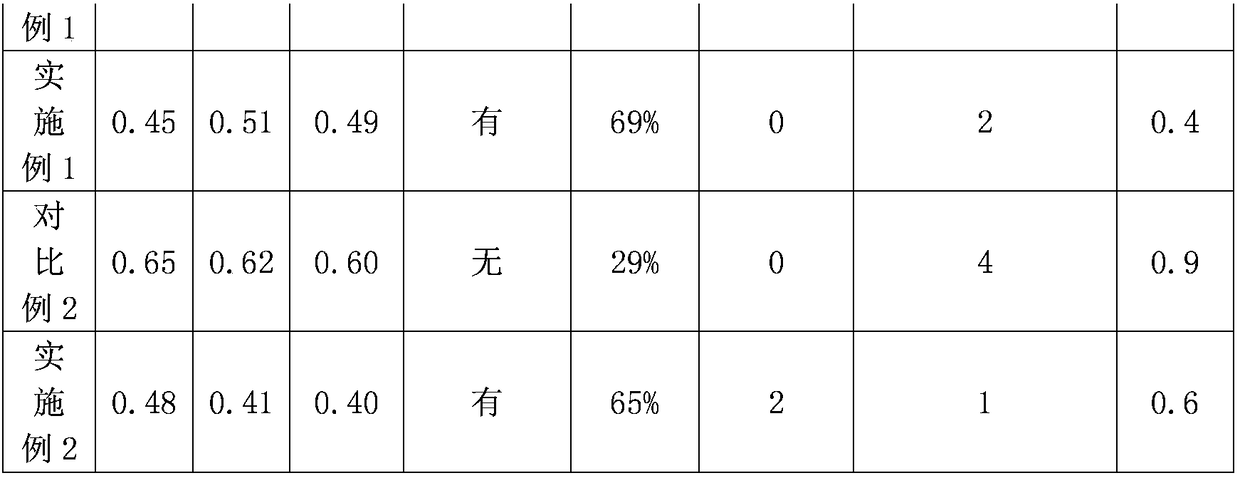Preparation method of OCA (Optical Clear Adhesive)
A technology of optical transparent glue and photoinitiator, which is applied in the direction of adhesives, film/sheet adhesives, film/sheet without carrier, etc. It can solve the problems of long curing cycle, environmental hazards, and long production. Achieve low cost, good aging resistance and rework performance, and good filling ink level difference
- Summary
- Abstract
- Description
- Claims
- Application Information
AI Technical Summary
Problems solved by technology
Method used
Image
Examples
Embodiment 1
[0024] The preparation method of an optically transparent glue of the present embodiment comprises the following steps: put the following reagents into a 2000mL three-necked flask equipped with a stirring paddle, a nitrogen inlet and a thermometer: 1160 grams of 2-ethylhexyl acrylate, hydroxyethyl acrylate 290 grams of esters, 40 grams of acrylic acid, 10 grams of lauryl acrylate, 1.5 grams of 1-hydroxycyclohexyl phenyl ketone, and 2 grams of 1-dodecanethiol. After passing high-purity (99.99%) nitrogen through the above device for 1 hour, turn on the 18w ultraviolet lamp and react for 10 minutes to obtain a prepolymer with a viscosity of about 1500 cps. After polymerization, 1.5 grams of 1,6-hexanediol diacrylate, 4.5 grams of styrene, 0.4 grams of 1-dodecanethiol and 1.2 grams of (2,4,6-trimethyl Benzoyl) diphenyl phosphine oxide, fully stirred and mixed for defoaming, and then the resulting mixture was coated on two layers of 75 μm thick silicone resin-treated polyethylene t...
Embodiment 2
[0026] The preparation method of an optically transparent glue of the present embodiment comprises the following steps: putting the following reagents into a 2000mL three-necked flask equipped with a stirring paddle, a nitrogen inlet and a thermometer: 1050 grams of 2-ethylhexyl acrylate, hydroxyethyl acrylate 290 grams of esters, 85 grams of isobornyl acrylate, 75 grams of lauryl acrylate, 1.5 grams of 1-hydroxycyclohexyl phenyl ketone, and 2 grams of 1-dodecanethiol. After passing high-purity (99.99%) nitrogen through the above device for 1 hour, turn on the 18w ultraviolet lamp and react for 10 minutes to obtain a prepolymer with a viscosity of about 1500 cps. After the polymerization reaction, 60 grams of hydroxyethyl acrylate, 4.8 grams of dipentaerythritol pentapropionate, and 1.2 grams of (2,4,6-trimethylbenzoyl) diphenylphosphine oxide were added to the prepolymer, After fully stirring and mixing, defoaming was carried out, and then the resulting mixture was coated on ...
experiment example
[0032] The performance of embodiment 1,2 and comparative example 1,2 is tested, and test method is as follows:
[0033] Dynamic Mechanical Thermal Analysis (DMTA)
[0034] Using an ARES G2 rheometer (available from TA Instruments, New Castle, Delaware, USA) on a PSA using parallel plates with 8 mm diameter plates and a gap of 1.5 mm Geometry performs DMA testing. The tests were performed with a temperature scan rate of 3°C / min at a frequency of 1 Hz and a maximum strain of 20%. Scans were performed from -20°C to 100°C.
[0035] Cut the OCA sample to be equal to the size of the glass substrate, and use a laminating machine to bond the OCA to the glass substrate with a certain ink level difference (close to 40 microns). The ink glass is then laminated to another glass without ink. The two glasses are then laminated using a laminator. At 50°C, 35 N / cm 2 The lamination was performed at a lamination pressure of 1000°C and a pressing time of 5 seconds. After lamination, the l...
PUM
| Property | Measurement | Unit |
|---|---|---|
| glass transition temperature | aaaaa | aaaaa |
| gel fraction | aaaaa | aaaaa |
| gel fraction | aaaaa | aaaaa |
Abstract
Description
Claims
Application Information
 Login to View More
Login to View More - R&D
- Intellectual Property
- Life Sciences
- Materials
- Tech Scout
- Unparalleled Data Quality
- Higher Quality Content
- 60% Fewer Hallucinations
Browse by: Latest US Patents, China's latest patents, Technical Efficacy Thesaurus, Application Domain, Technology Topic, Popular Technical Reports.
© 2025 PatSnap. All rights reserved.Legal|Privacy policy|Modern Slavery Act Transparency Statement|Sitemap|About US| Contact US: help@patsnap.com


